Report

Introduction
A global mining company seems an unlikely hero in a story about inclusion and diversity (I&D).
But in 2016, the world’s largest mining group, BHP, announced plans to support greater balance in the gender mix of its workforce by 2025. At the time, the company had a base of 17% women, which is not unusual in an industry that’s about 80% male. The company’s leaders said that BHP needed to better reflect the diverse communities in which it worked.
Action followed the announcement. BHP added inclusive language to its charter (“we are successful when our teams are inclusive and diverse”), redesigned tasks to remove gender and demographic bias, and expanded apprentice programmes that encourage applications from women and indigenous people. The company created flexible working options for all employees, and it created formal sponsorship programmes for women. In every department, in every mine, in every location—action was taken to make sure language and behaviour became intentionally inclusive.
Two years into its initiative, BHP is focusing on a sustained effort to meet its aspirational targets over time. And BHP’s inclusion index (which covers topics such as having a workplace free from harassment, leaders communicating commitment to diversity and the employee experience) has improved, bringing with it better business outcomes. In fact, BHP’s most diverse and inclusive teams exceed the company average on a range of performance metrics: They have lower injury rates and better adherence to work plans and production targets.
The progress is encouraging. It’s also replicable.
In this report, Bain & Company presents practical recommendations to help organisations build more diverse and inclusive workplaces. Our findings are based on in-depth pilots with multiple FTSE 100 clients, an extensive survey of UK employees, interviews with leaders and experts, and Bain & Company’s extensive global research on inclusion and diversity.
Through all of our experiences, we’ve found that sustained corporate action can make a difference, even from the most difficult starting points.

Five Actions to Improve Inclusion and Diversity in the Workplace
Sustaining these actions can help leaders gain traction.
Taking action
There is a strong correlation between diversity and better corporate performance. It’s increasingly well documented that decision making, return on investment, innovation and the ability to capture new markets all improve when diversity is present in the workplace.
Despite the benefits, diverse groups remain underrepresented at senior levels of businesses in the UK and Ireland. Even with business, political and societal pressure on the issue, inclusion and diversity remains elusive to many companies.
As of September 2018, 30% of FTSE 100 board seats were filled by women. But the metrics among FTSE 350 companies continue to fall short, and the number of women in chief executive positions remains staggeringly low (see Figure 1).
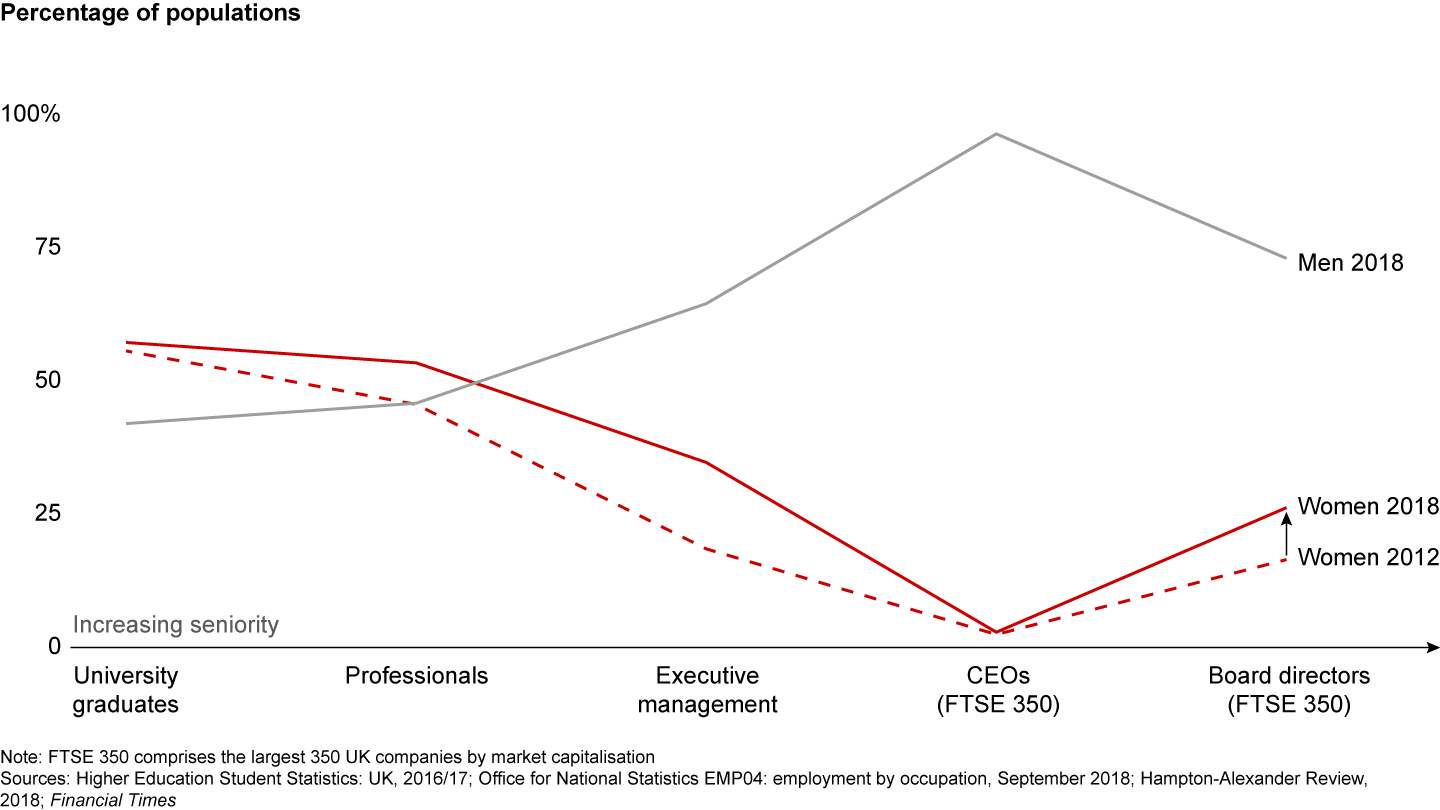
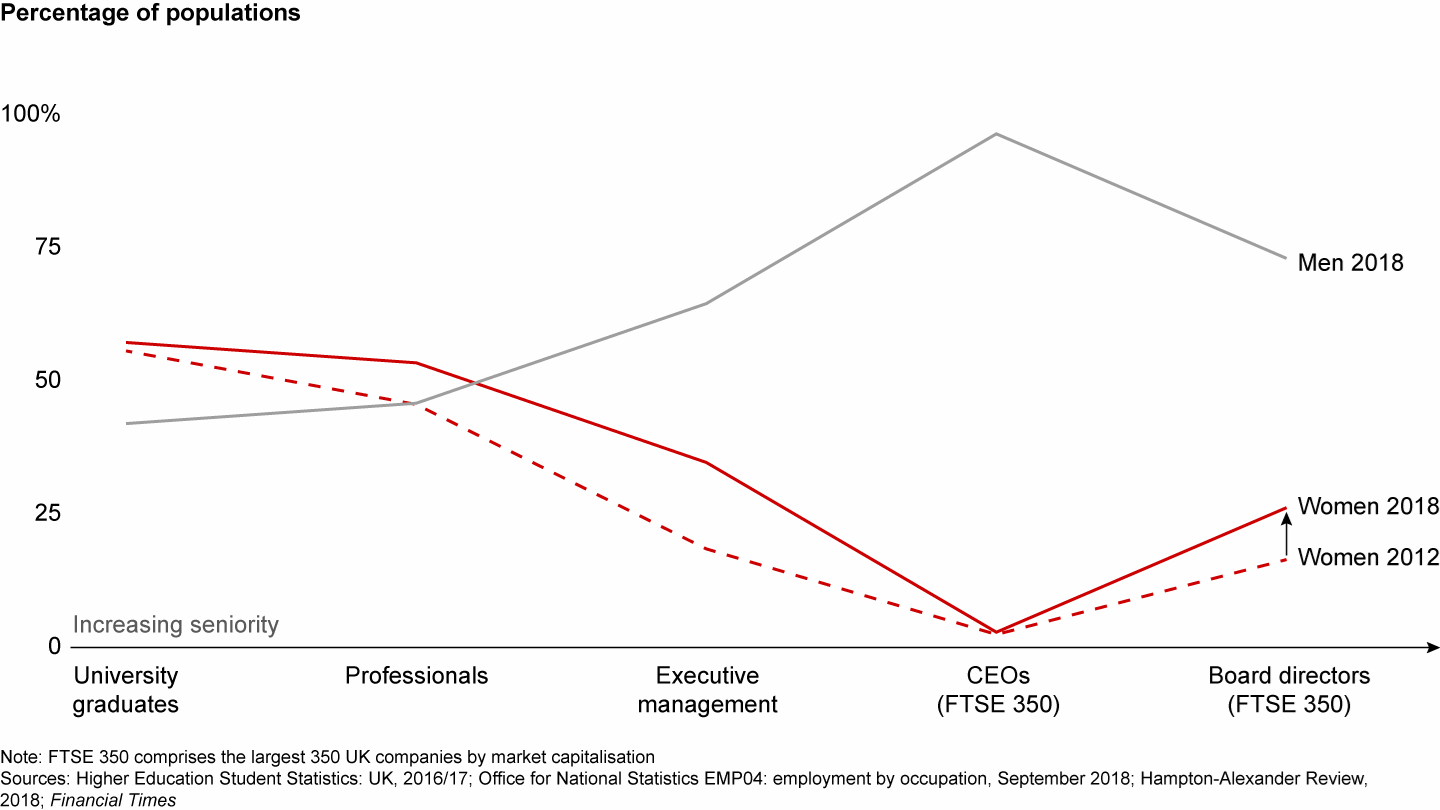
The situation for other minority groups is harder to assess because the data is tracked less frequently, but performance appears mixed at best. Black, Asian and minority ethnic (BAME) representation on FTSE 100 boards increased 2% between 2014 and 2017, topping out at 8%. But BAME representation in executive and CEO roles in FTSE 100 companies actually declined from 2014 to 2016.
In addition to underrepresentation, our research shows that minority employees have lower engagement scores, feel less included and have less confidence that they can reach senior leadership positions despite having the same ambition as other employees to do so (see Figure 2). Minority engagement drops even further when intersectionality (for example, BAME women) enters the picture (see Figure 3).
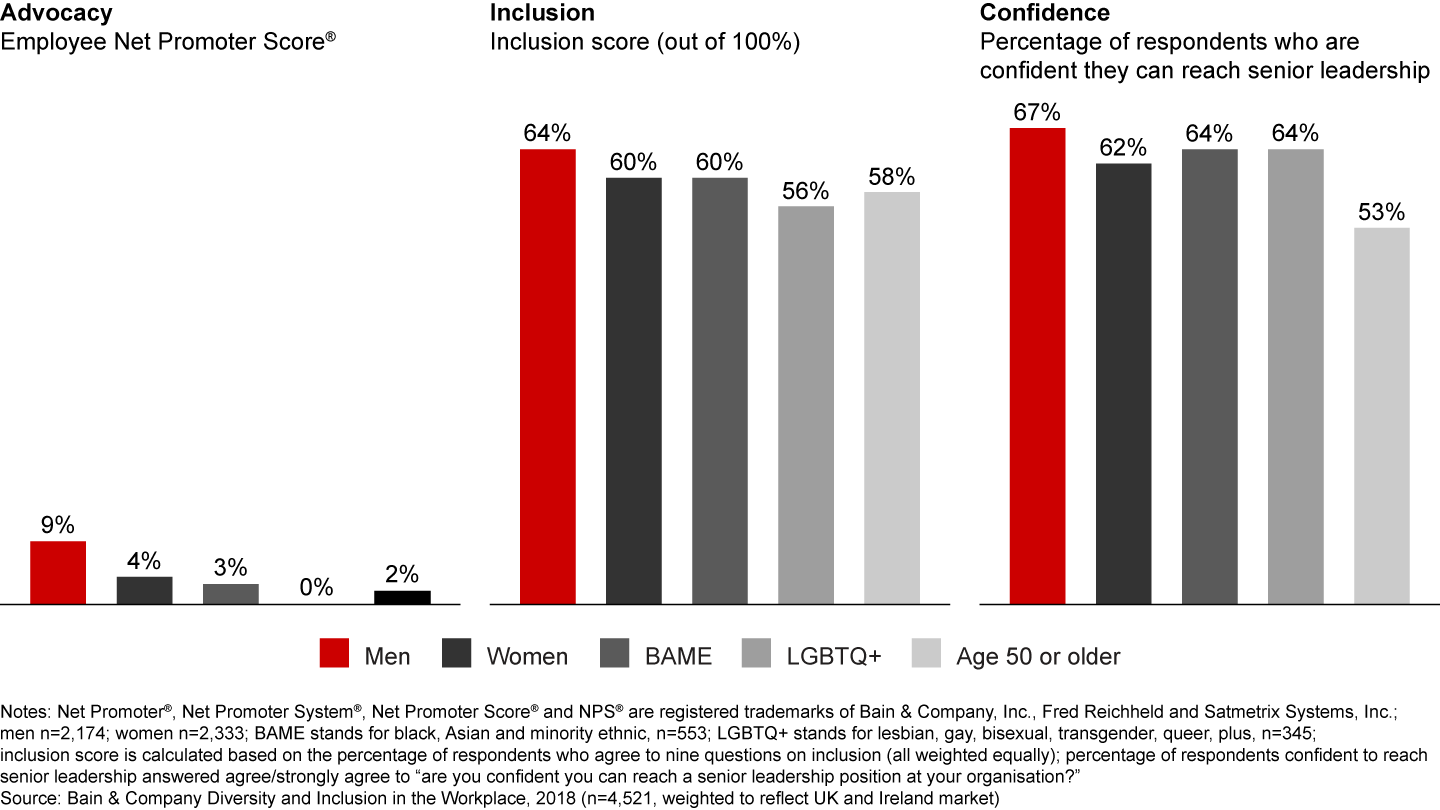
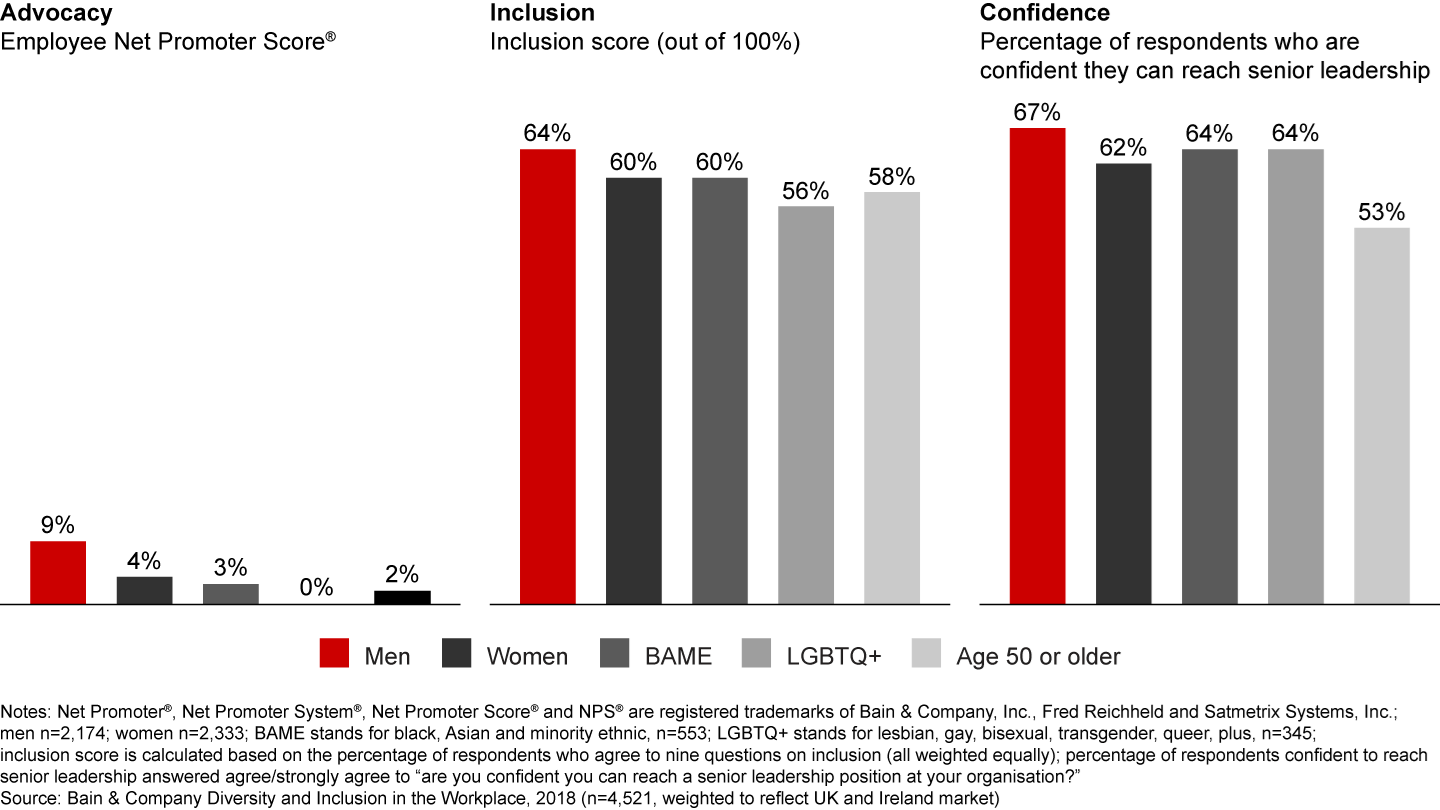
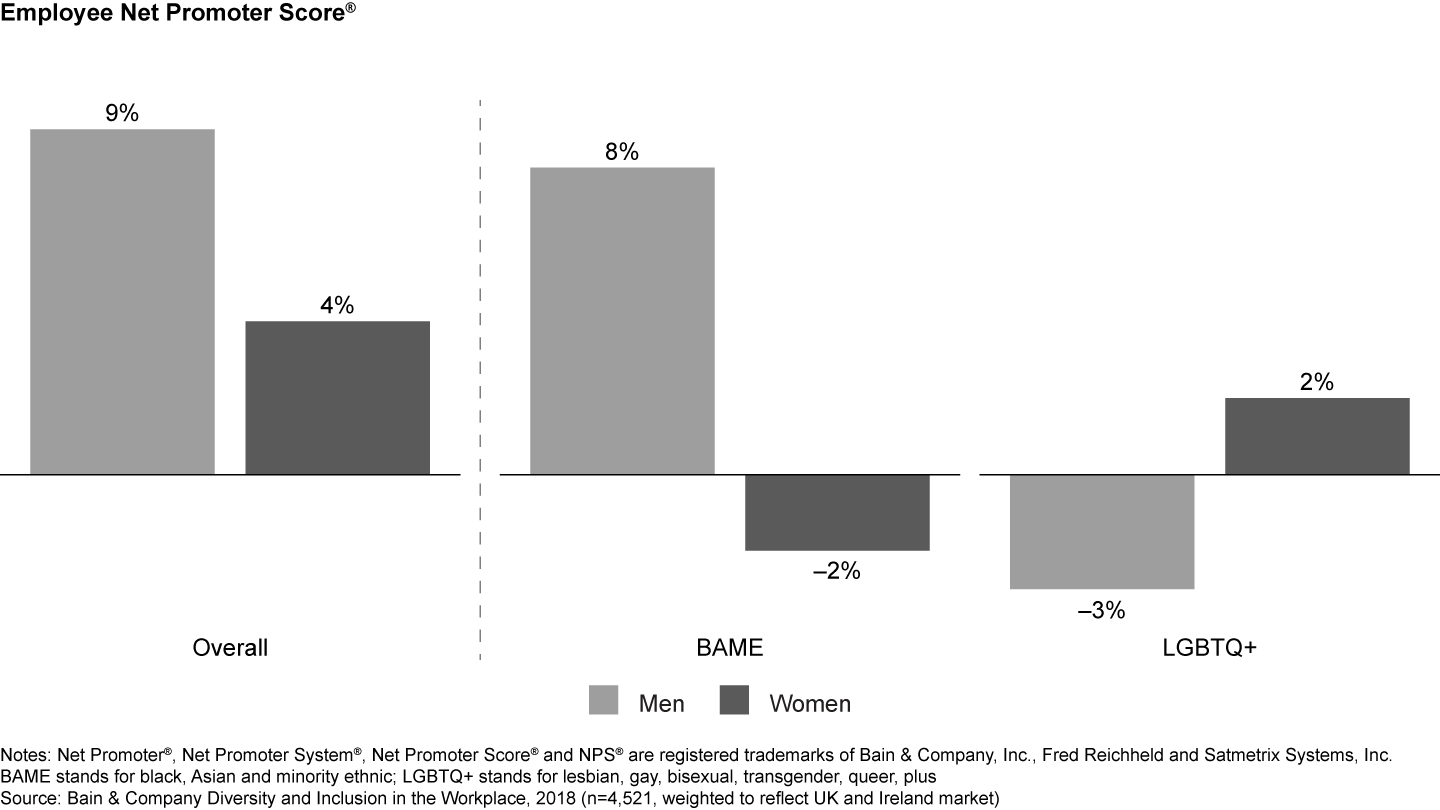
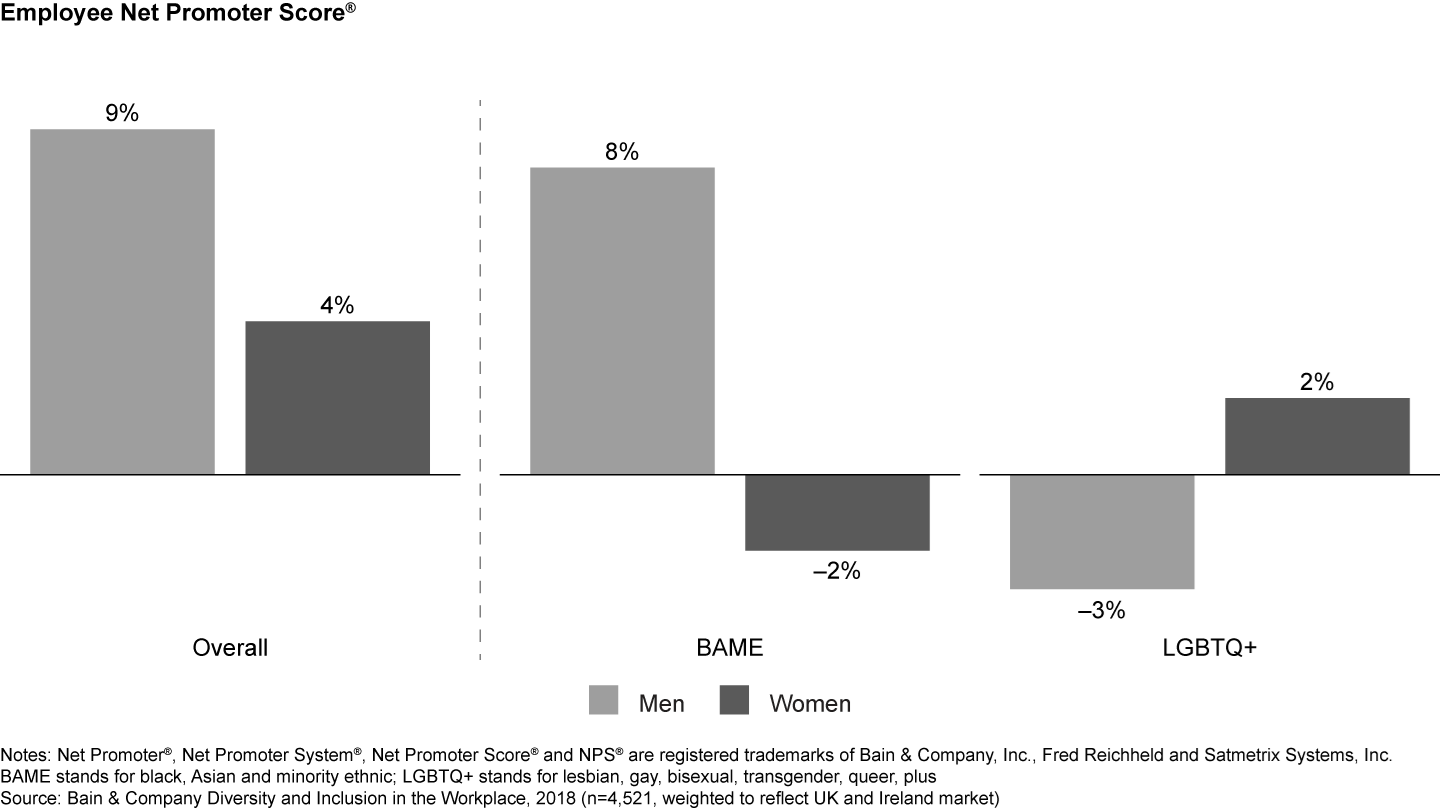
These intangible factors, such as how people feel about their workplace, matter. Employee engagement has proven and quantifiable impacts on company performance. Companies with a higher employee Net Promoter Score ® have distinct competitive advantages over other firms, including greater retention, higher levels of employee advocacy, overall better performance and faster growth.
I&D progress isn’t easy, but there is a path forward. Using data from the Hampton-Alexander Review, a UK government-appointed independent review body focused on increasing female representation on FTSE 350 boards, we see that companies with similar contexts, such as industry, sector and geography, achieve wide variations in their levels of diversity (see Figure 4). In short, corporate action can make a difference.
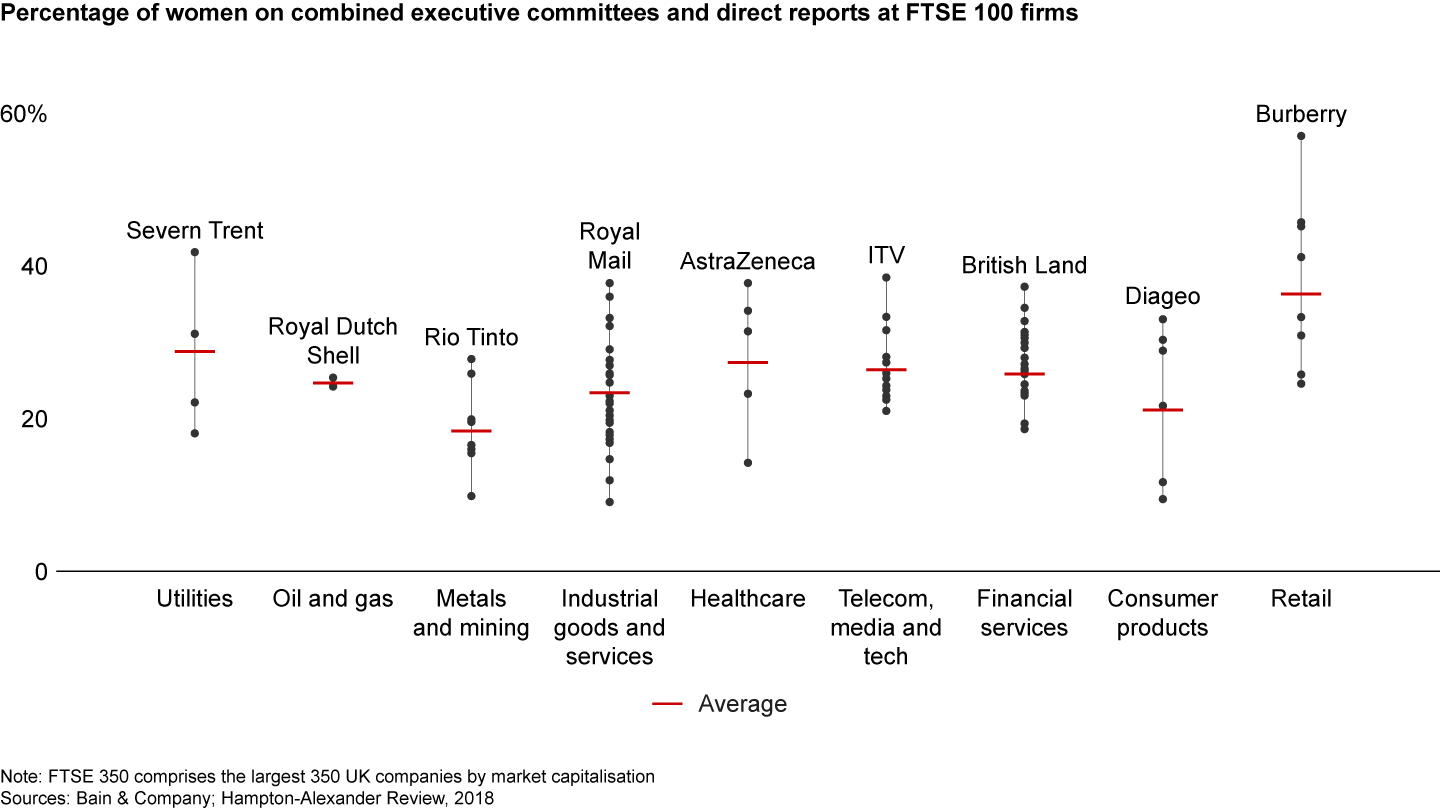
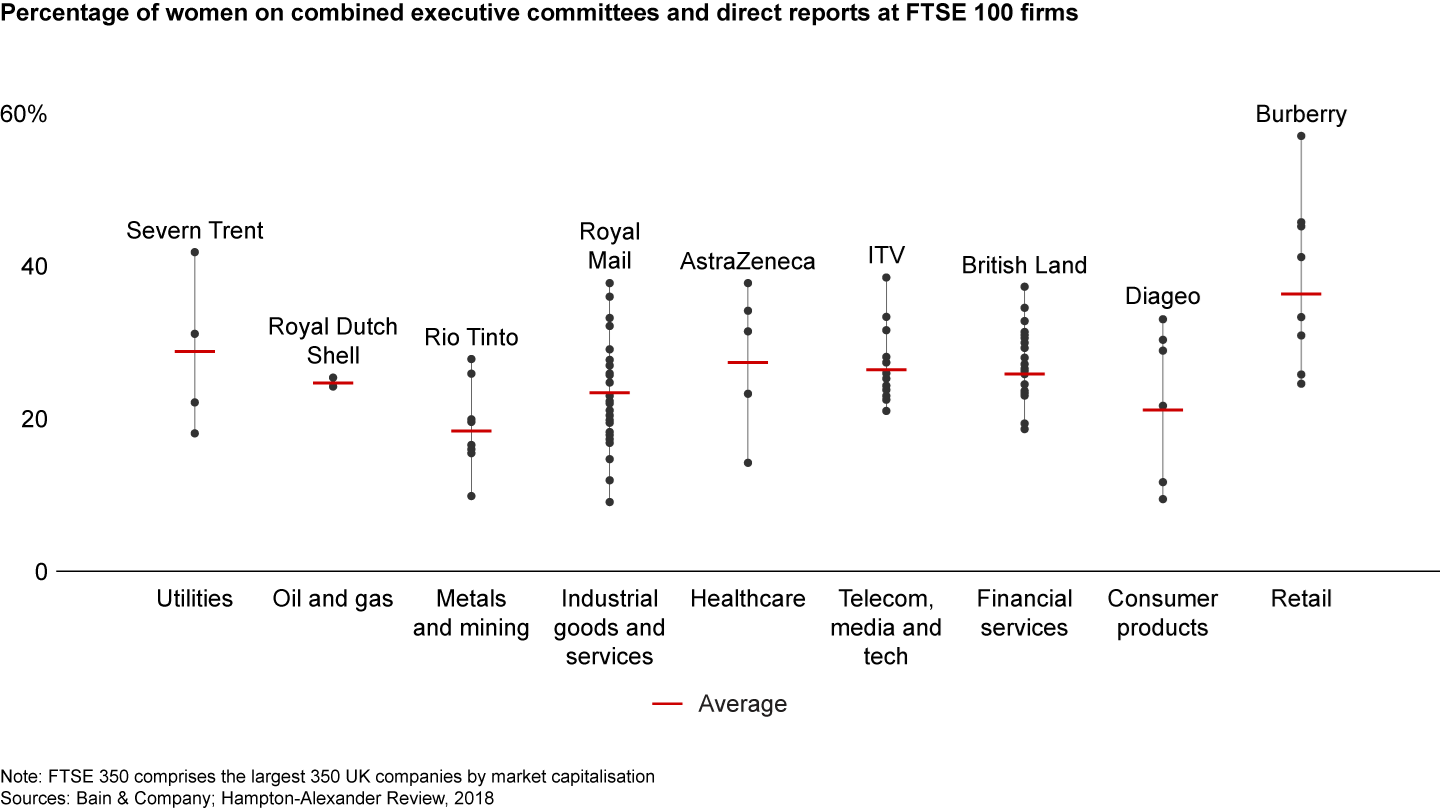
Our research found five specific actions that are effective in improving inclusion and diversity (see Figure 5).
- Focus on facts.
- Lead and cascade.
- Mitigate bias systematically.
- Prioritise carer support, flex and sponsorship.
- Communicate intentionally and inclusively.
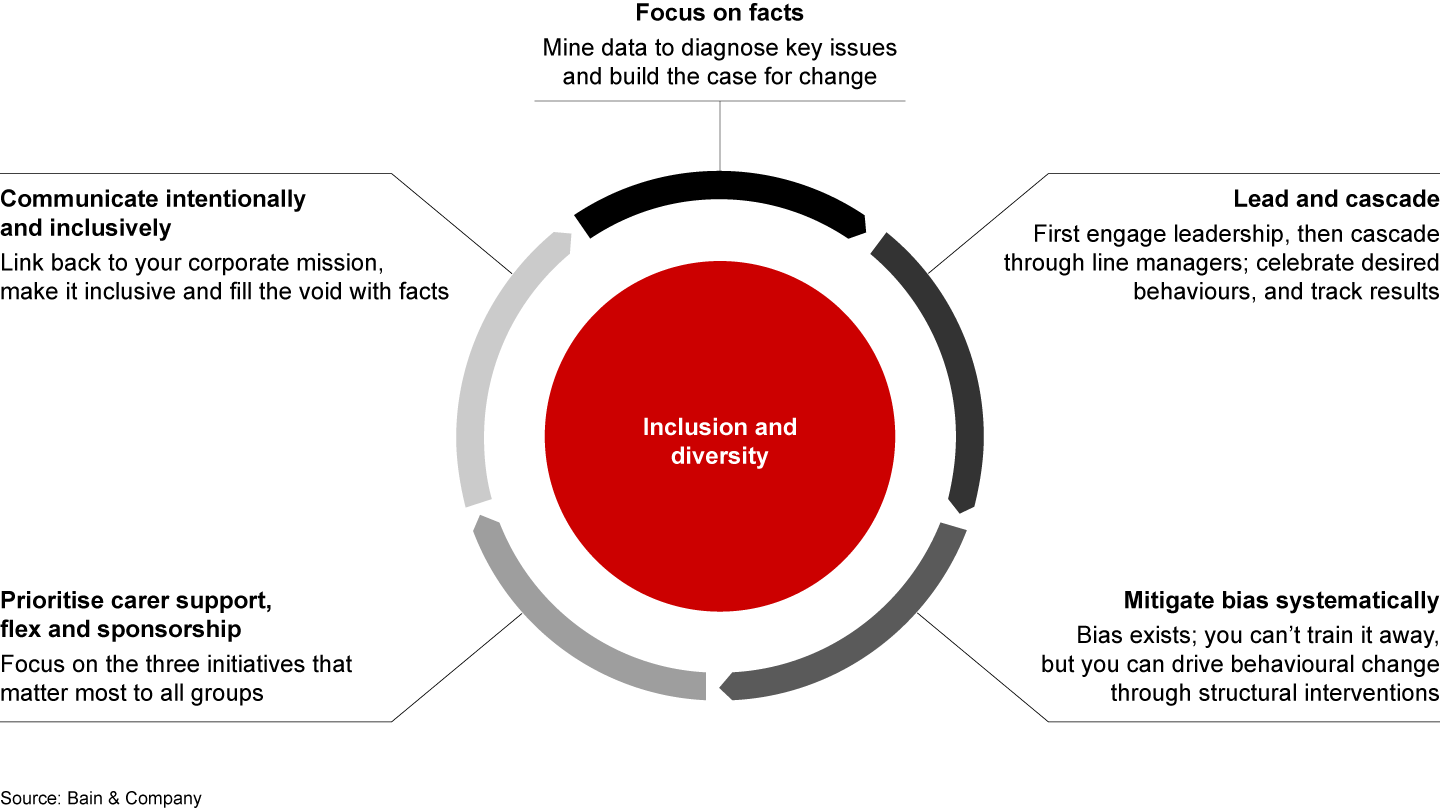
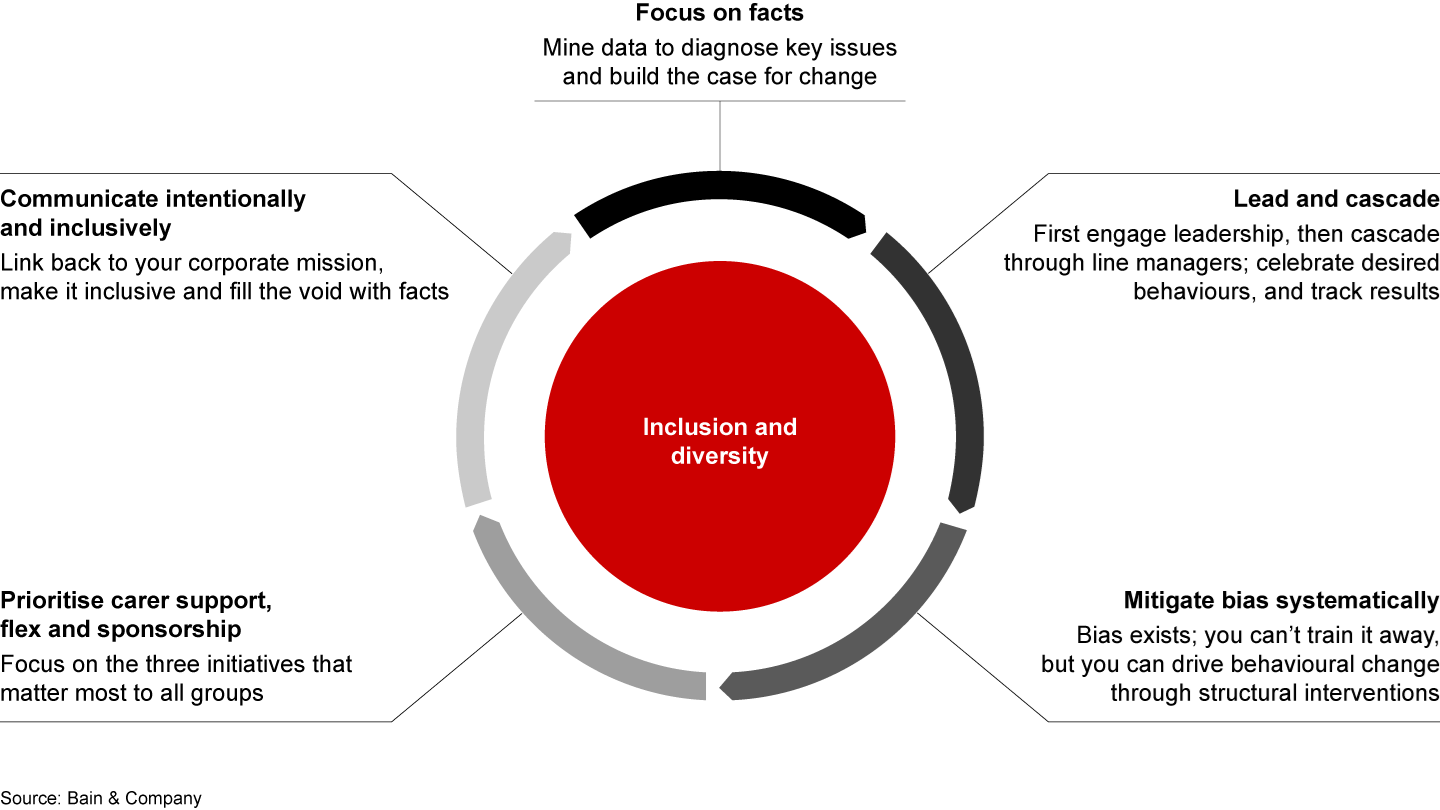
Focus on facts
In most organisations, I&D data is patchy at best. To enable change, organisations need a clear and factual understanding of their starting point.
Backed by data rather than assumptions, leaders often reset their approach. For example, PriceWaterhouseCooper (PwC), a global professional services firm, assumed that a gender imbalance among senior-level employees was the result of women leaving the workforce.
In response, it invested in retention and maternal support programmes for women. But the data revealed that male attrition was higher than female attrition at every level above junior employees. Regardless of who left the company (men or women), PwC had predominantly been replacing its experienced “leavers” with men. Once PwC had a clear, data-supported understanding of the situation, it shifted its initiatives. Rather than focus solely on female retention, PwC addressed female recruitment efforts for experienced positions to help close the gender gap at its more senior levels.
But what data should inform action?
Firstly, find the starting point. How many men, women and minority group members work in the organisation overall? And how are those groups represented across geographies, business units, functions and rank?
Secondly, map the data across the talent life cycle—recruitment, promotion and retention—to see how the organisation attracts and develops diverse employees. Using this information, executives can model how the workforce will evolve in the future. For example, we used talent life cycle data to show one company how it would never reach gender parity in its leadership team at its current recruitment, promotion and retention rates. The data identified recruitment as the most influential factor keeping the company from its parity goals (see Figure 6).
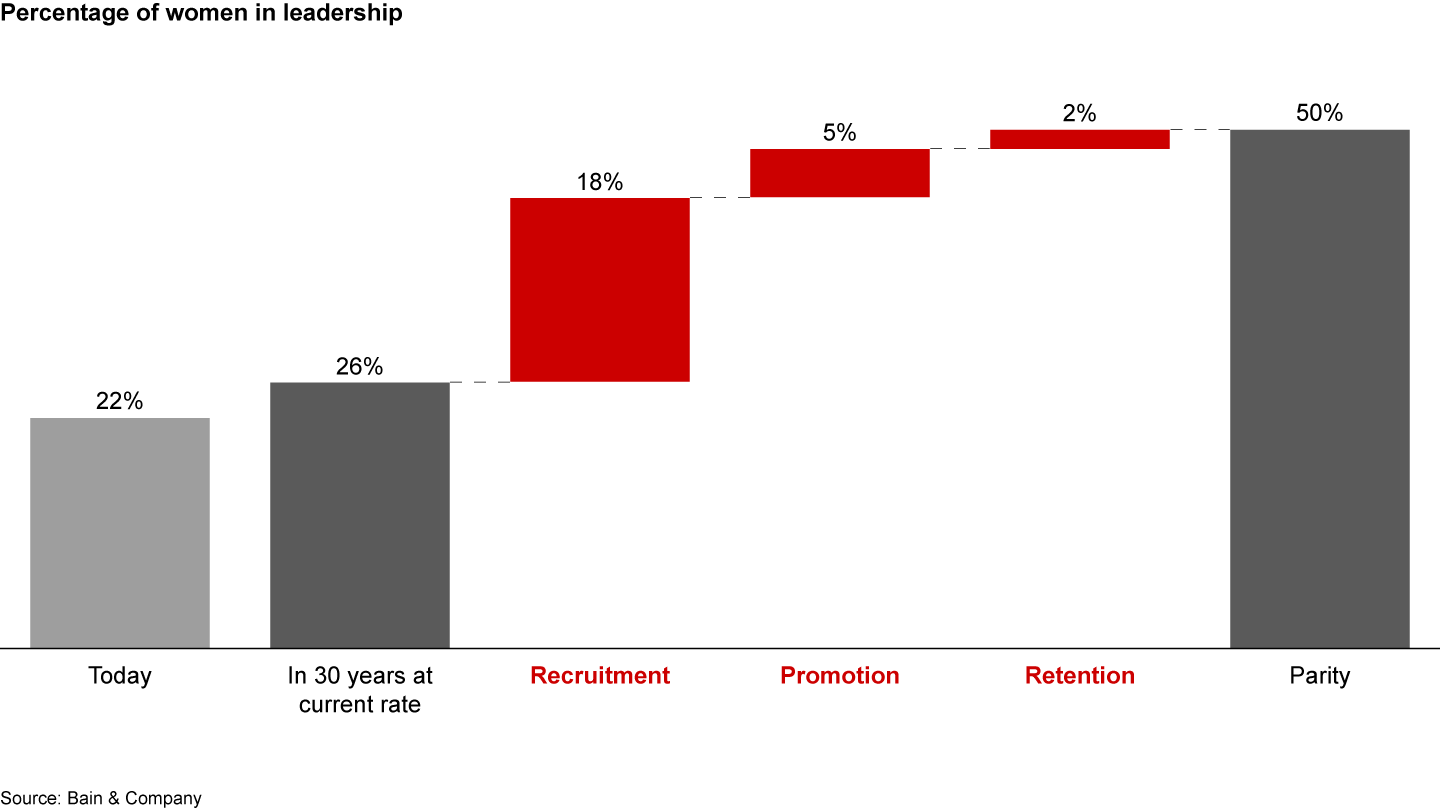
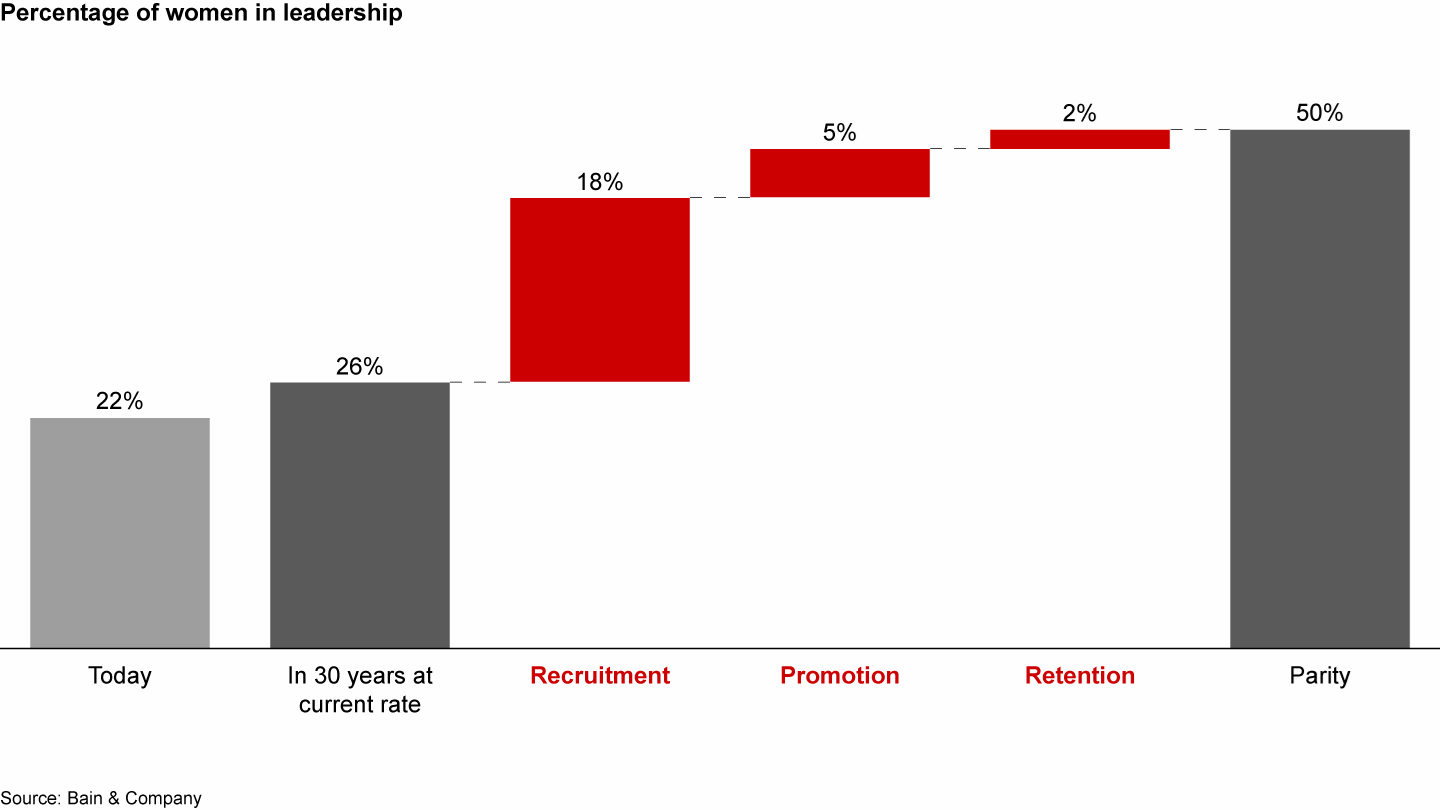
Thirdly, seek to understand how employees feel about the organisation and their potential within it. Employees’ perceptions are key inputs to an effective I&D strategy (see Figure 7). Find out how workers perceive leadership’s commitment and the efficacy of available programmes and initiatives; ask how included, engaged and confident they feel in the workplace; and understand where unconscious bias mitigations are required.
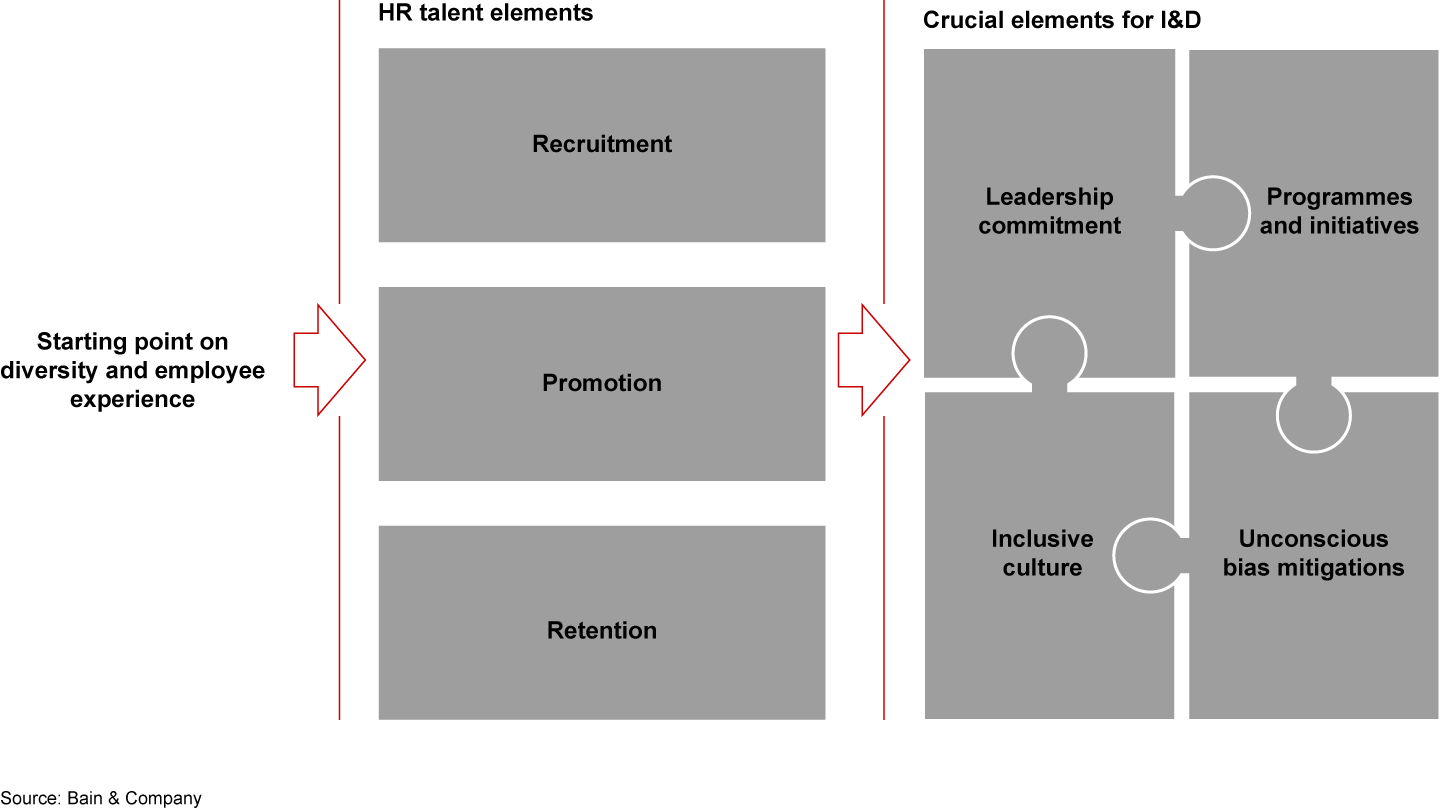
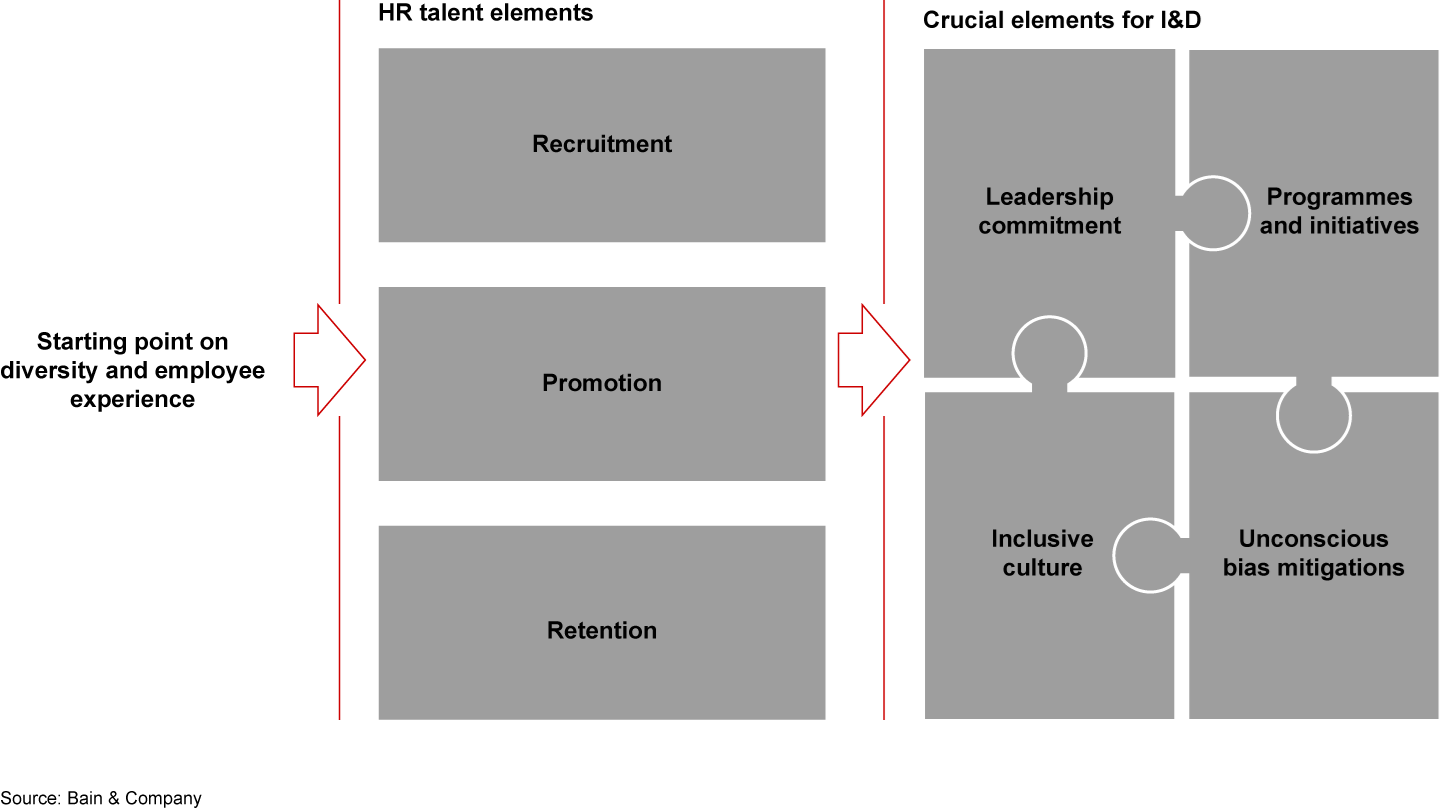
Lead and cascade
Visible and committed leadership is the most critical factor in creating equal opportunities for diverse talent in the workplace (see the Bain Brief “Actions Speak Louder than Words: CEO Conduct That Counts”). According to our study, employees’ feelings of inclusion nearly double when leaders make inclusion and diversity a visible priority (see Figure 8).
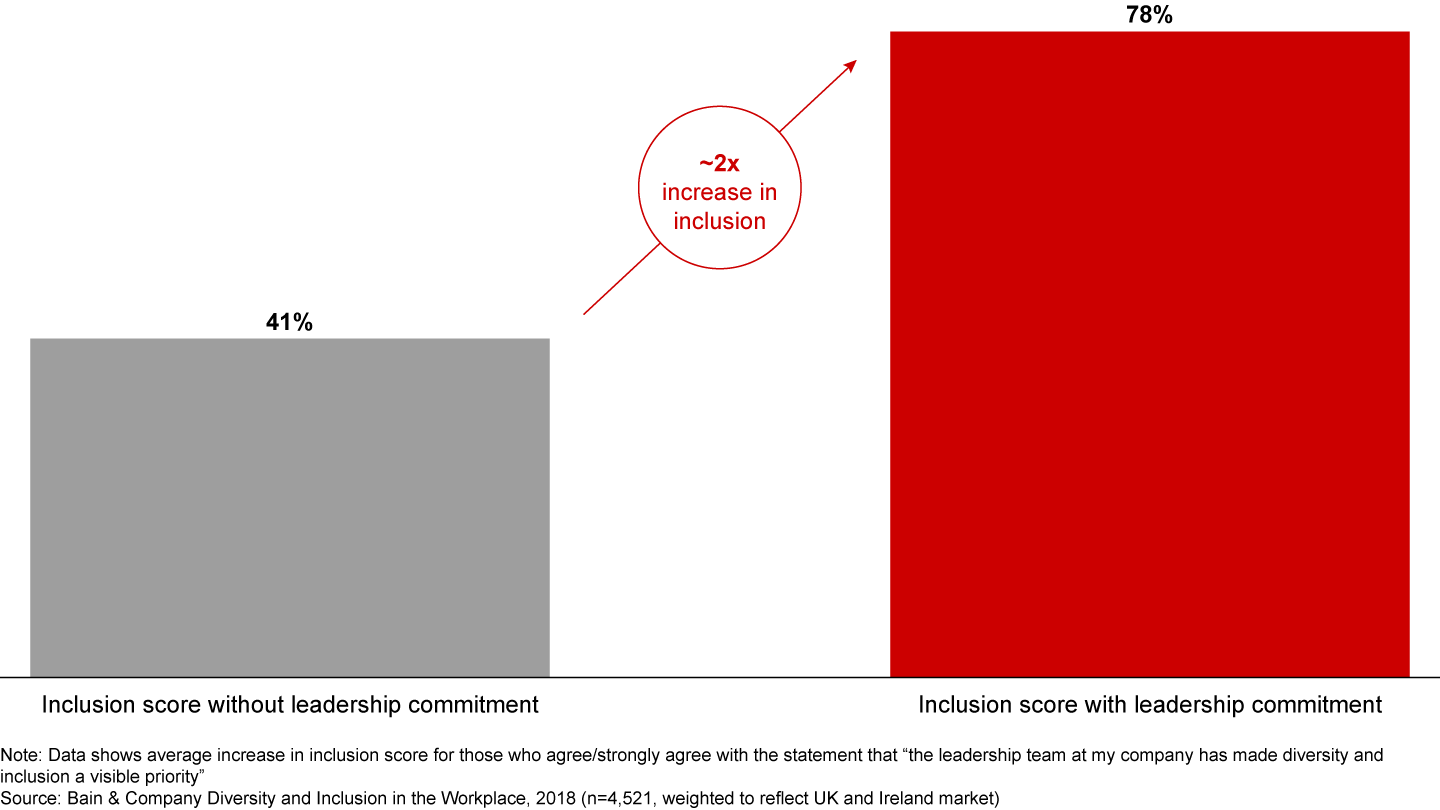
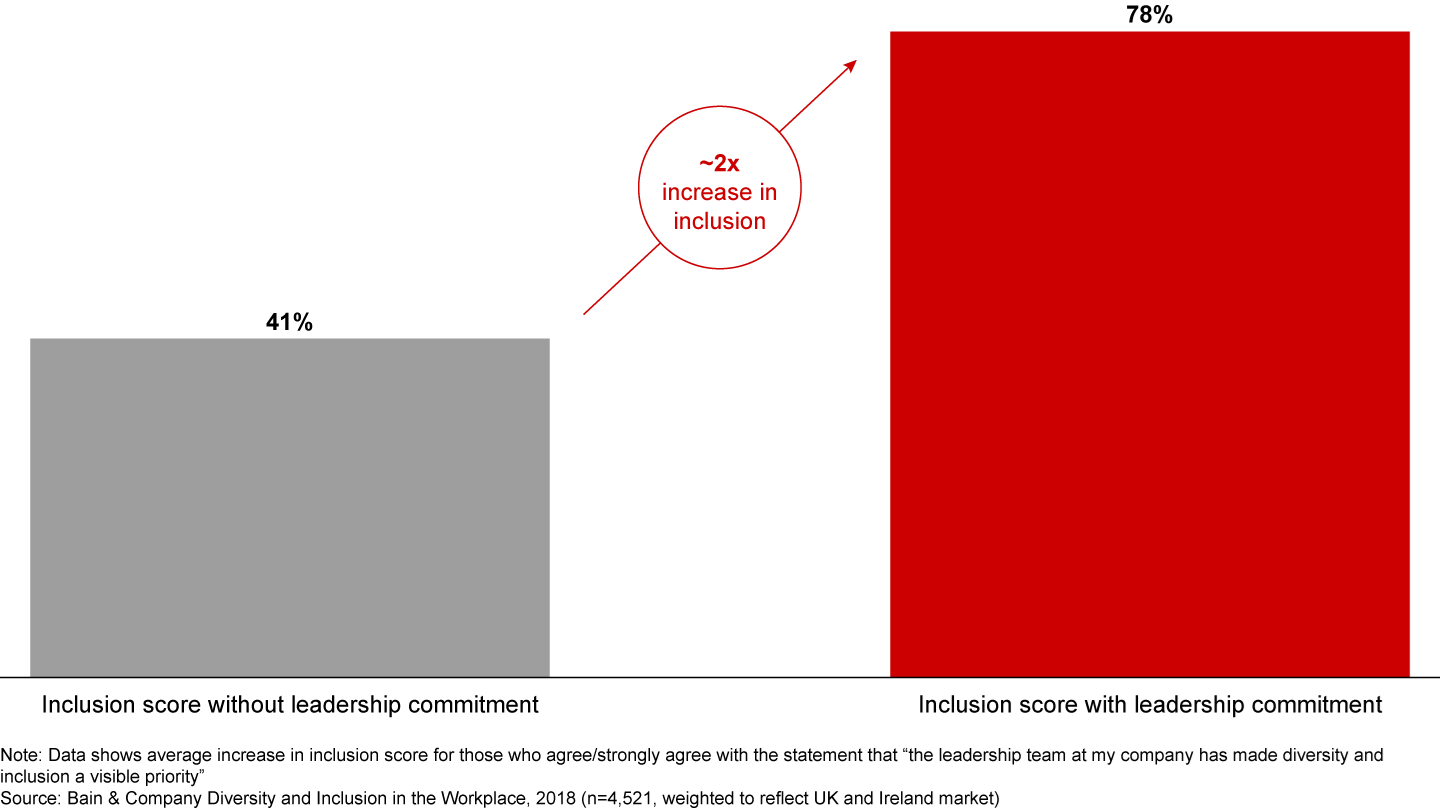
The task, then, is to define and deploy leadership commitment. Executives should approach inclusion and diversity just as they would tackle any other strategic initiative.
• Secure buy-in from the top team.
• Engage line managers with specific, time-bound goals.
• Embed and celebrate desired behaviours.
• Track results, and solicit feedback.
Secure buy-in from the top team
Inclusion and diversity must be established as a nonnegotiable commitment among the top team and embedded into the vision, values and culture of an organisation.
One way to cement commitment is to put it in writing. Diageo, an FTSE 100–listed multinational beverage company, recognised inclusion and diversity as critical to its culture more than 15 years ago. At the time, the company amended its corporate values statement to add “we value each other.” Diageo made diverse people and perspectives part of the company’s narrative, rather than an afterthought. Today, Diageo is considered a global diversity pioneer.
Engage line managers with specific, time-bound goals
Commitment to inclusion and diversity must cascade from the boardroom to the front line, supported by line managers along the way. Employees need to know that inclusion and diversity are important to their direct boss as “proximity trumps seniority” (see the Bain Report Everyday Moments of Truth: Frontline Managers Are Key to Women’s Career Aspirations).
Embed and celebrate desired behaviours
Culture reflects a company’s everyday behaviours at scale. When a culture is inclusive, companies report 58% higher engagement, as measured by their employee Net Promoter Score.
Many organisations are daunted by the prospect of changing culture. But two small steps can make important strides toward building an inclusive environment: senior executives role modelling inclusive behaviour; and promoting inclusive everyday behaviours across the board.
People from minority groups are less likely to feel as though they have role models in their organisation to whom they can relate. For example, LGBTQ+ (lesbian, gay, bisexual, transgender, queer, plus) men in the UK are 26% less likely to feel as though they have role models at work compared with non-LGBTQ+ men, increasing the importance of conscious role modelling and championing of diverse candidates.
Senior leaders set the tone for the rest of the company. Our research indicates that having a CEO or executive team member model inclusive behaviour can increase an employee Net Promoter Score by 59%, regardless of his or her own identity profile.
Respectful and honest exchanges between line managers and their reports can help foster a sense of value and belonging for everyone, regardless of demographic group. Seemingly small gestures, such as a line manager openly leaving the office early to care for a child, may help employees recognise their own potential to balance work and personal demands and to be successful. Such behaviours and observations accumulate over time and help colleagues determine whether they feel valued and respected in the workplace.
Companies can support managers to act by articulating inclusive behaviour and promoting its use in the workplace. Daily, line managers can take the following actions to foster inclusion and diversity.
- Get to know the diverse individuals on your team. Understand their goals and ambitions, both at work and at home.
- Be a sponsor. Encourage individuals to pursue the right opportunities to further their careers, and visibly advocate for them.
- Promote different types of flexible working arrangements to all members of your team, and celebrate positive performance outcomes.
- Actively promote inclusive behaviour within your team. Make sure all voices are heard in meetings; solicit feedback from employees who don’t typically contribute.
- Be transparent about your own lifestyle boundaries. Make it clear when you leave early for a child’s school event or other personal commitments.
Track results, and solicit feedback
Similar to any strategic initiative, I&D programme results must be tracked and evaluated against the agreed-upon goals. Some companies have implemented inventive mechanisms to secure employee feedback. Centrica, a British multinational energy and services company, established a reverse mentoring programme to help experienced leaders learn from their millennial employees. Centrica is learning what younger employees value and using that feedback to shape the company’s culture.
Mitigate bias systematically
While unconscious bias had evolutionary benefits to early humans, it can result in suboptimal decision making in the modern workplace. Human brains process information differently when it comes from people we perceive as dissimilar to us, which influences how we think, behave and interact.
Employees in the UK and Ireland reported experiencing bias in the workplace. Our survey found that women are more likely than men to be told to be more confident, and women are three times more likely than men to say that they received feedback on how they dress (see Figure 9).
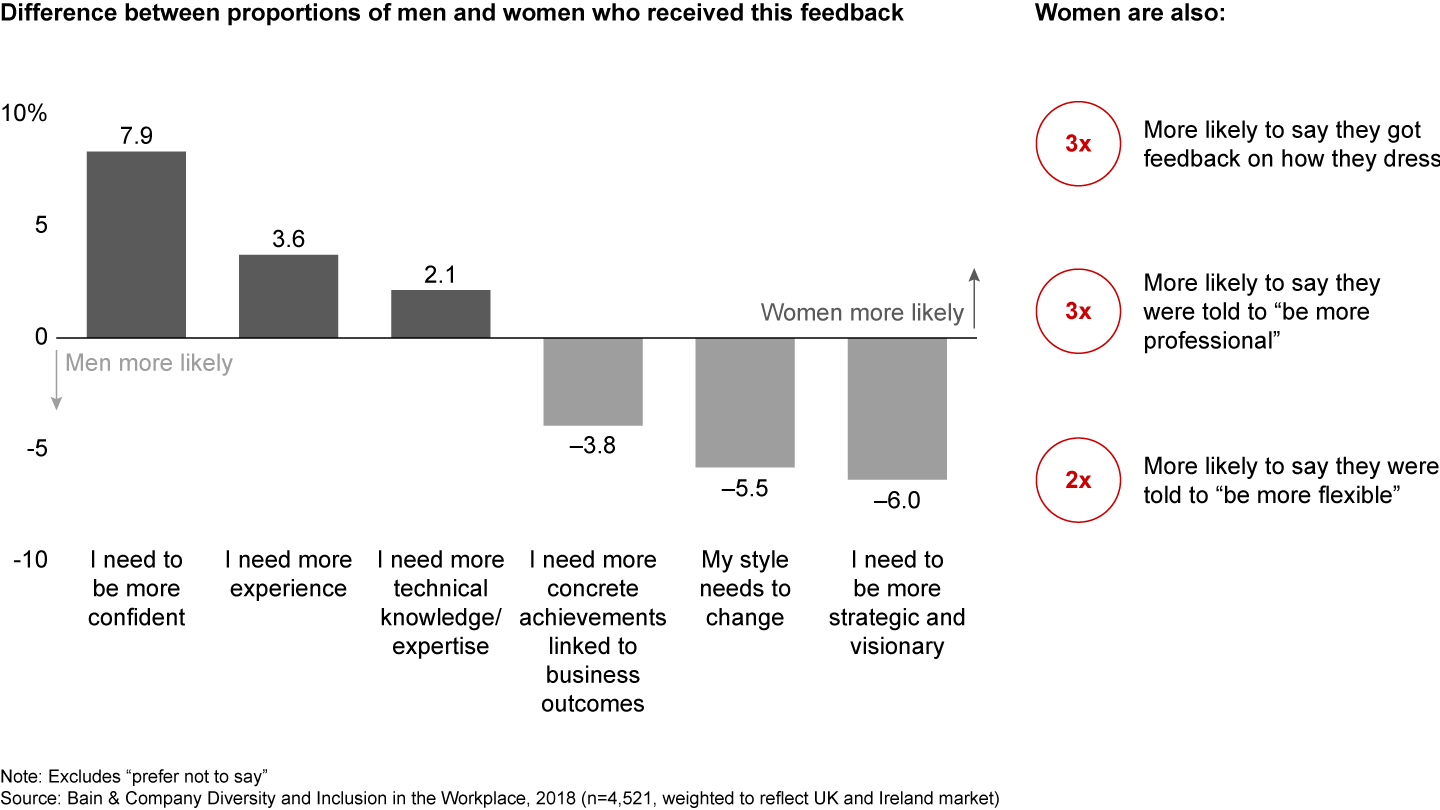
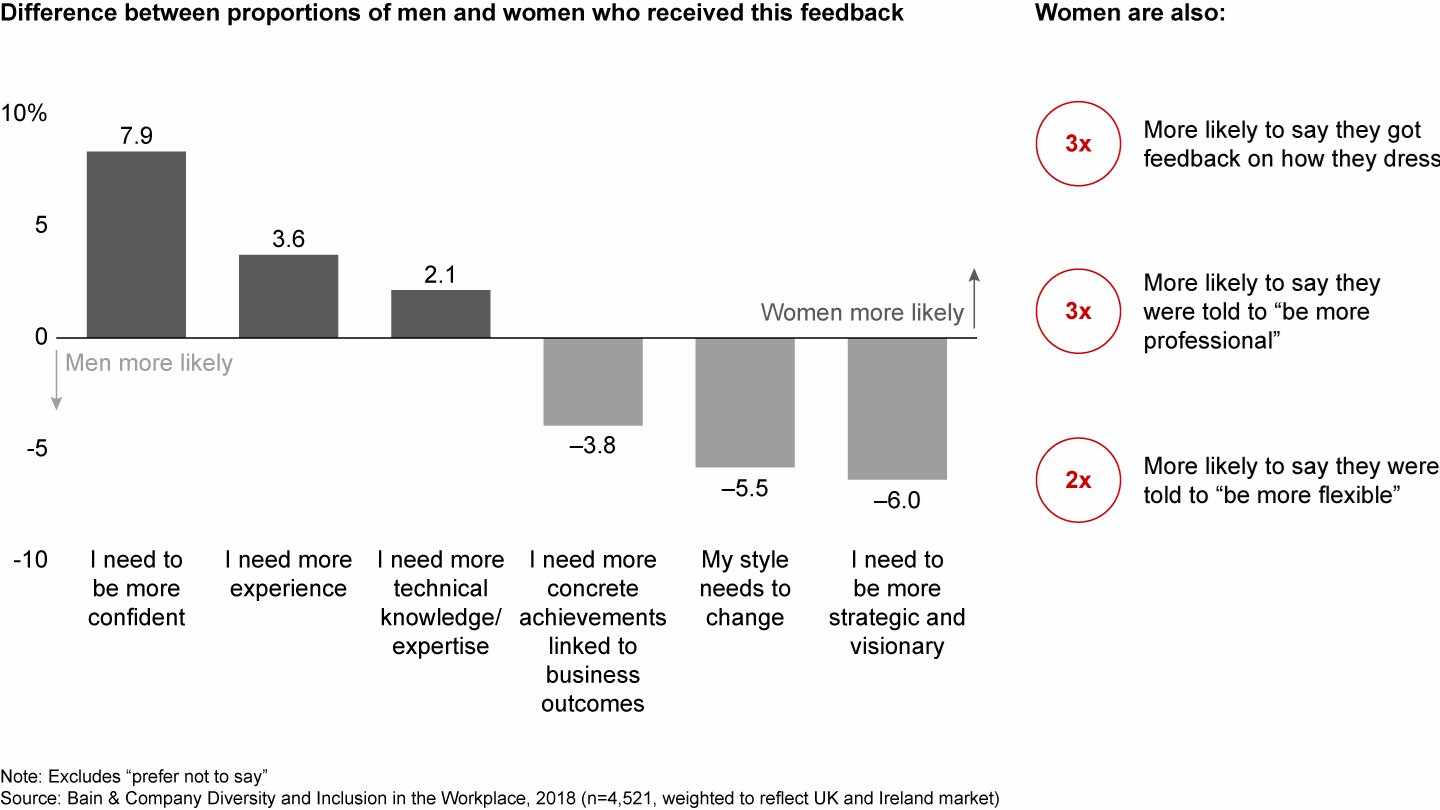
US companies are trying to tackle this issue, spending an estimated $8 billion annually on training programmes, with little evidence to suggest meaningful efficacy (see the Bain Brief “Charting the Course: Getting Women to the Top”). Research that examined more than 800 companies over roughly 30 years found that minority representation in management actually decreased after mandatory diversity training was introduced compared with companies where no diversity training was delivered or the training was voluntary.
Because it’s difficult to train away bias, it’s more effective to establish processes to mitigate them. Start by defining where bias can influence key decisions, and then put systems in place to diminish those prejudices. Bias may exist at any point in the talent life cycle, but obvious focal points are recruiting, promotion, performance evaluations and project assignment processes.
At these points, systematic mitigations can be embedded into processes to counteract bias. For example, job descriptions can be written toward capabilities rather than sector-specific terms that may limit the candidate pool to “more of the same.” Candidate pools can be identified in other ways, such as through anonymising software or standardised tests instead of unstructured interviews.
Common issues with bias in recruiting |
Proven mitigations |
| Job descriptions: Certain language and information appeals more to certain groups; asking for relevant experience will get you “more of the same” recruits. |
|
| Applications: Applicant pools aren’t sufficiently diverse. |
|
| Screening: Diverse candidates are screened out of the process. |
|
| Interviews: Unstructured interviews don’t highlight the best candidates. |
|
Prioritise carer support, flex and sponsorship
Shifting demographics and population dynamics are changing the modern workplace. As examples, a “sandwich generation” has emerged, composed of employees who must care for both their children and their parents. Also, dual-career households are on the rise. Nearly half of UK households with dependent children have two parents who work full time. Meanwhile, the youngest generations of workers, millennials and Generation Z, are rewriting career paths in general. Instead of holding a single full-time job, they often meet their earning needs through “portfolio careers,” comprising a combination of part-time roles and freelance or temporary assignments.
The message to employers is loud and clear: Employees need help balancing their multifaceted lives. Twenty percent of caregivers in the UK said that their work has been negatively impacted by their caregiving demands, and 2.3 million people have given up work altogether.
Our survey sought out the most effective initiatives to help companies foster inclusion and diversity and support diverse workplace needs. Among all populations surveyed, the same three progressive programmes mattered most to employees (see Figure 10):
- carer support, such as emergency dependent care and in-office childcare;
- flexible working arrangements, the ability to regularly work from home, to work part-time or shifted hours, or to take sabbatical leave; and
- formal sponsorship from leaders who advocate for and support diverse employees’ career development.
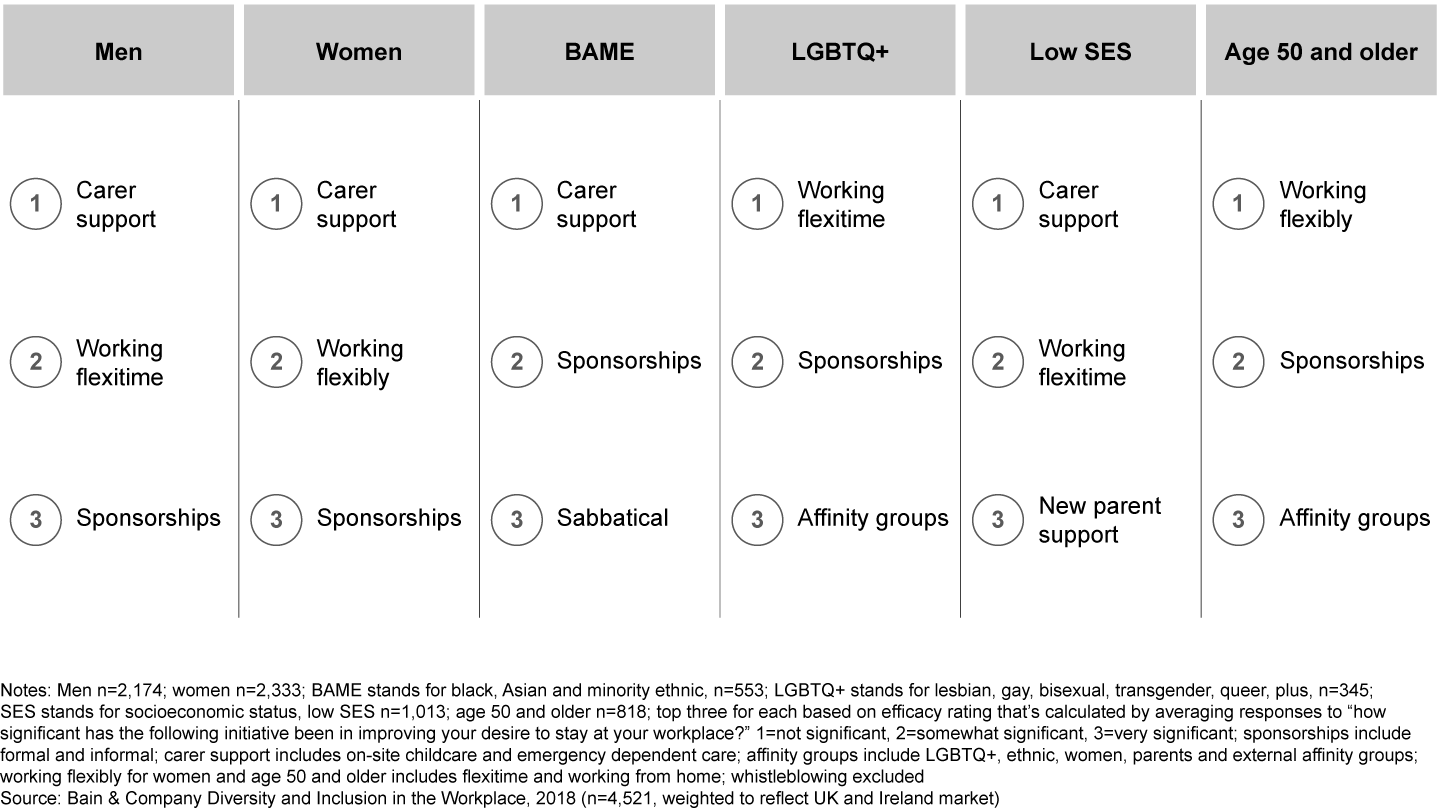
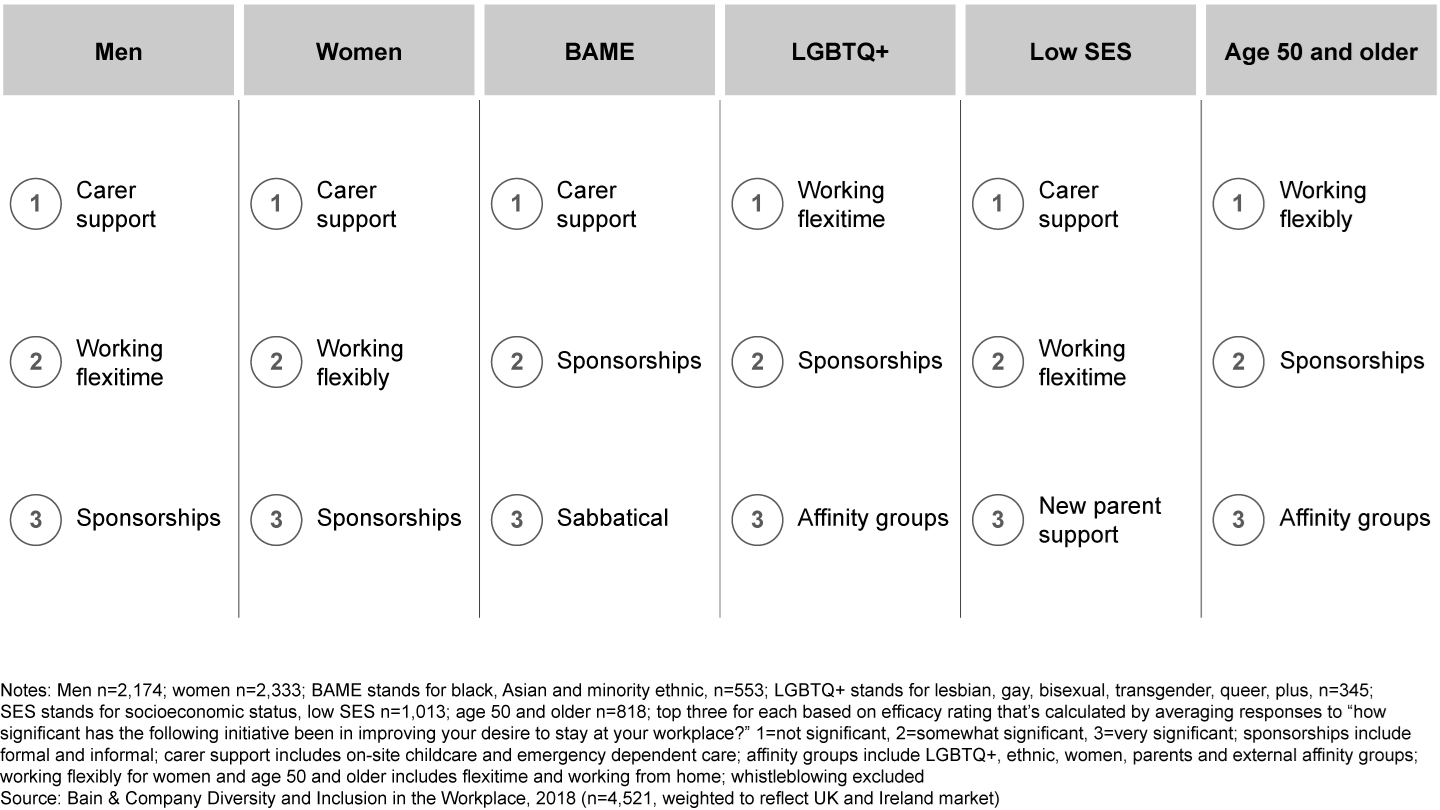
Carer support for all
The need to balance caregiving and career affects every gender and age group in the workforce. Younger men reported feeling a greater sense of family responsibility than previous generations, with slightly more than 50% of men age 25 to 44 reporting that they share household duties equally with their partner. However, only 5% of UK businesses offer childcare in the workplace. And senior workers, who carry significant knowledge and experience, are increasingly limiting or ending their careers to meet the needs of their elderly parents or older relatives.
The conclusion: Carer support is important to everyone, not just women. Workers of the future, across every demographic, will face an increasing need to balance carer roles with workplace demands. Effective carer support, in addition to maternity and paternity benefits, will be critical for employers to recruit and retain talent.
Flexible working arrangements for all
Most UK and Ireland employers offer flexible working options; 80% of respondents had part-time work options available to them, and more than 60% said they could work flex time or from home. But stigma around such arrangements persists. Our survey found that 39% of men and 38% of women believed using flex work would negatively impact their career trajectory. And only half of respondents felt that flex was supported by their supervisors (see Figure 11).

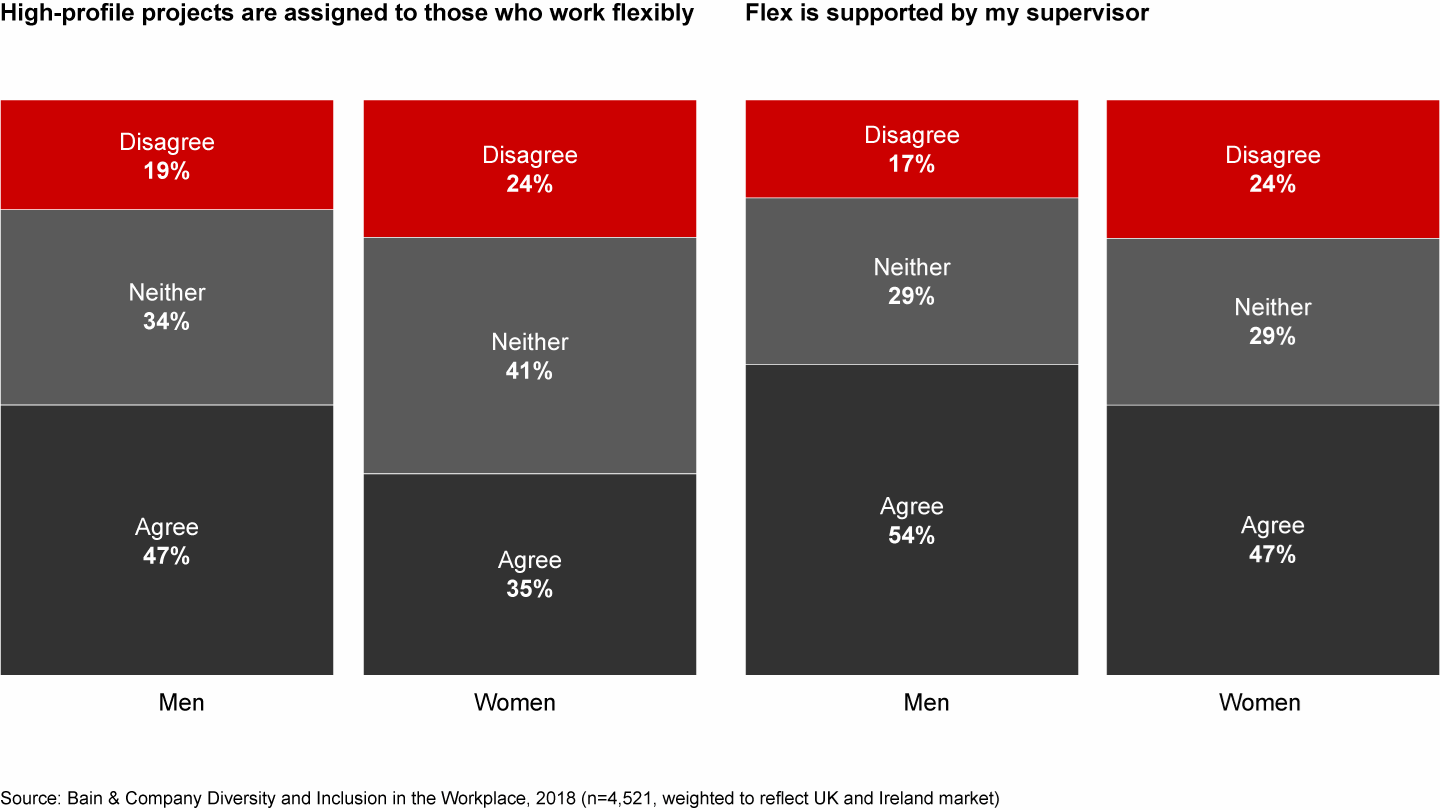
The benefits, however, are clear. When offered, supported and used by all, flexibility has the potential to increase employee advocacy by 37%.
Fiona Vines, who leads I&D efforts at BHP, stressed that workplace flexibility is possible, even in nontraditional work environments. “In operational environments in mines, working from home is really not possible. But we give people choice,” she explained. “Roster choice or timetable choice—whatever choice we can offer sends a strong signal of trust.”
Vines noted that men at BHP have adopted flexible work options just as enthusiastically as women, and that has positively affected employees’ overall mindset about I&D initiatives.
Companies we’ve seen successfully adopt flex options:
- make carer support and flexible working arrangements available to all employees;
- build cultural support for flex work, starting with a strong commitment from the CEO and cascading down through leadership teams and line-level managers;
- encourage senior leaders to use flexible working schedules and to share their experiences with employees;
- put technology and processes in place to support flex work;
- establish and communicate clear policies for flex work, particularly as they relate to promotion practices (see the Bain Brief “Integrating Work and Life”); and
- ensure that high-profile and challenging projects are assigned to flex workers so that they continue to grow and progress in their careers.
Emma Stewart, MBE, CEO and cofounder of Timewise, describes the three steps that companies can take to embrace flexible working options—namely, aligning leadership, examining culture and ensuring capabilities.
Formal sponsorship for diverse groups
Sponsors are individuals of influence who advocate for others to ensure that they are considered for relevant roles or opportunities. They give concrete opportunities, rather than advice. Sponsorship can occur in addition to mentorship, but it is more effective than merely having a professional sounding board. Women, for example, have been shown to be overmentored and undersponsored compared with their male peers. Without sponsorship, women are less likely than men to be appointed to top roles.
Research from Moving Ahead, a UK-based social enterprise focused on improving workplace diversity and inclusion, has shown that structured and formal sponsorship programmes are more effective than organic or self-directed initiatives, particularly for minority groups. Formal programmes provide more clarity and purpose, have more specific expectations and are easier to assess. They also have defined beginning, middle and end points, so closing or changing the relationship is not viewed as a failure.
Sponsorship has also proven to be important for women, who may be less inclined to build these relationships naturally (see the Bain Report Creating a Positive Cycle: Critical Steps to Achieving Gender Parity in Australia). At EY, a global professional services firm, a formal sponsorship programme called “Career Watch” matched high-performing female and ethnic minority managers with partners in their business lines. The objective was to champion the sponsees toward positions in senior management. EY credits the programme, in part, with a 7% increase in BAME representation at its partner level since 2011.
Communicate intentionally and inclusively
No two people see or experience inclusion and diversity the same way, making it a divisive subject and a key challenge to overcome.
The issue is perception. Employees from different backgrounds can look at the exact same leadership team, or the same set of actions, and perceive them very differently. As an example, our survey found that men are 23% more likely than women to agree that their leadership team is sufficiently diverse.
An even larger perception gap existed between senior and junior employees: Senior leaders are twice as likely to believe that gender parity is a visible priority within their organisation than their employees and twice as likely to believe that their organisation had effective initiatives in place to promote inclusion and diversity. Also, senior employees, men and women, are more likely to believe that their organisation’s senior leadership team is sufficiently diverse (see Figure 12).
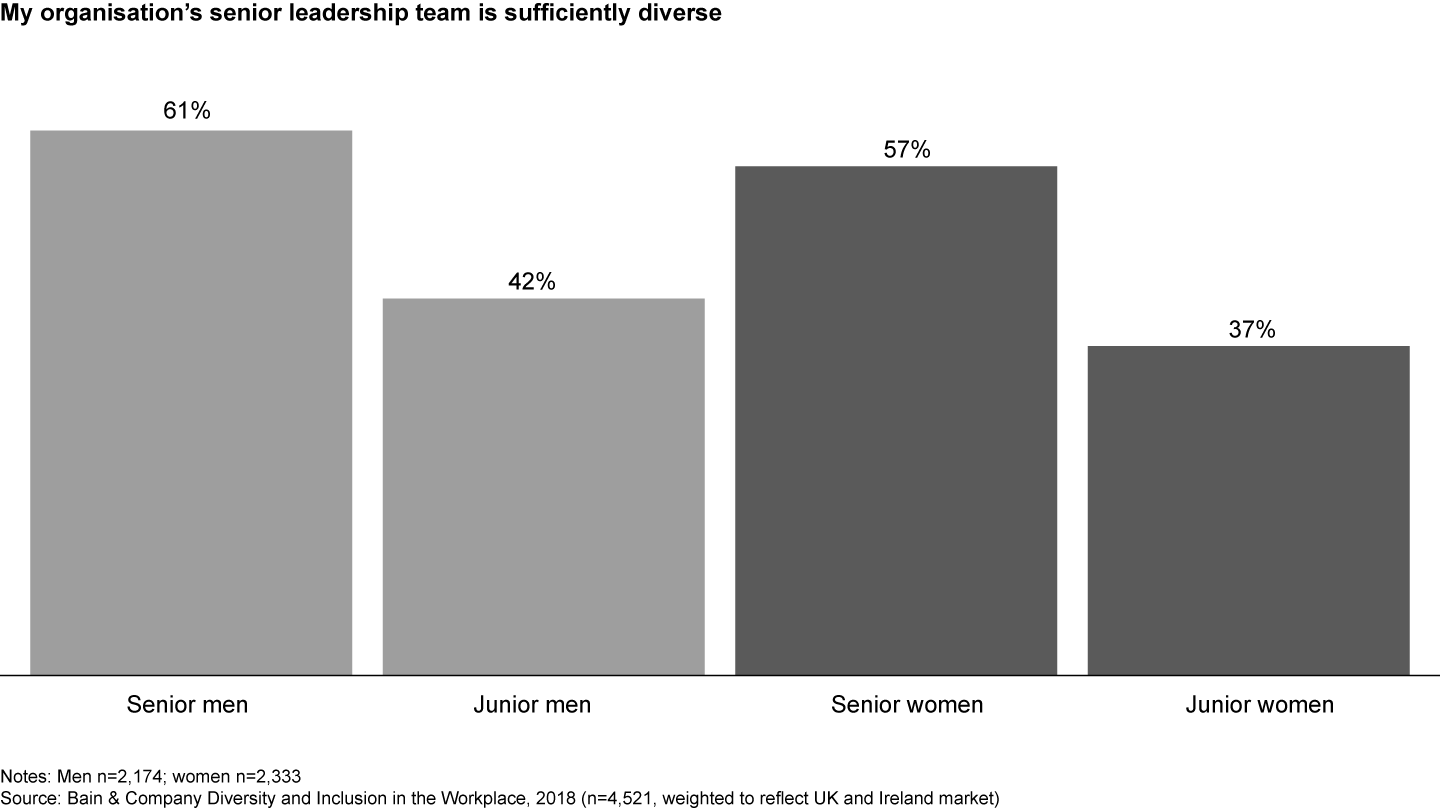
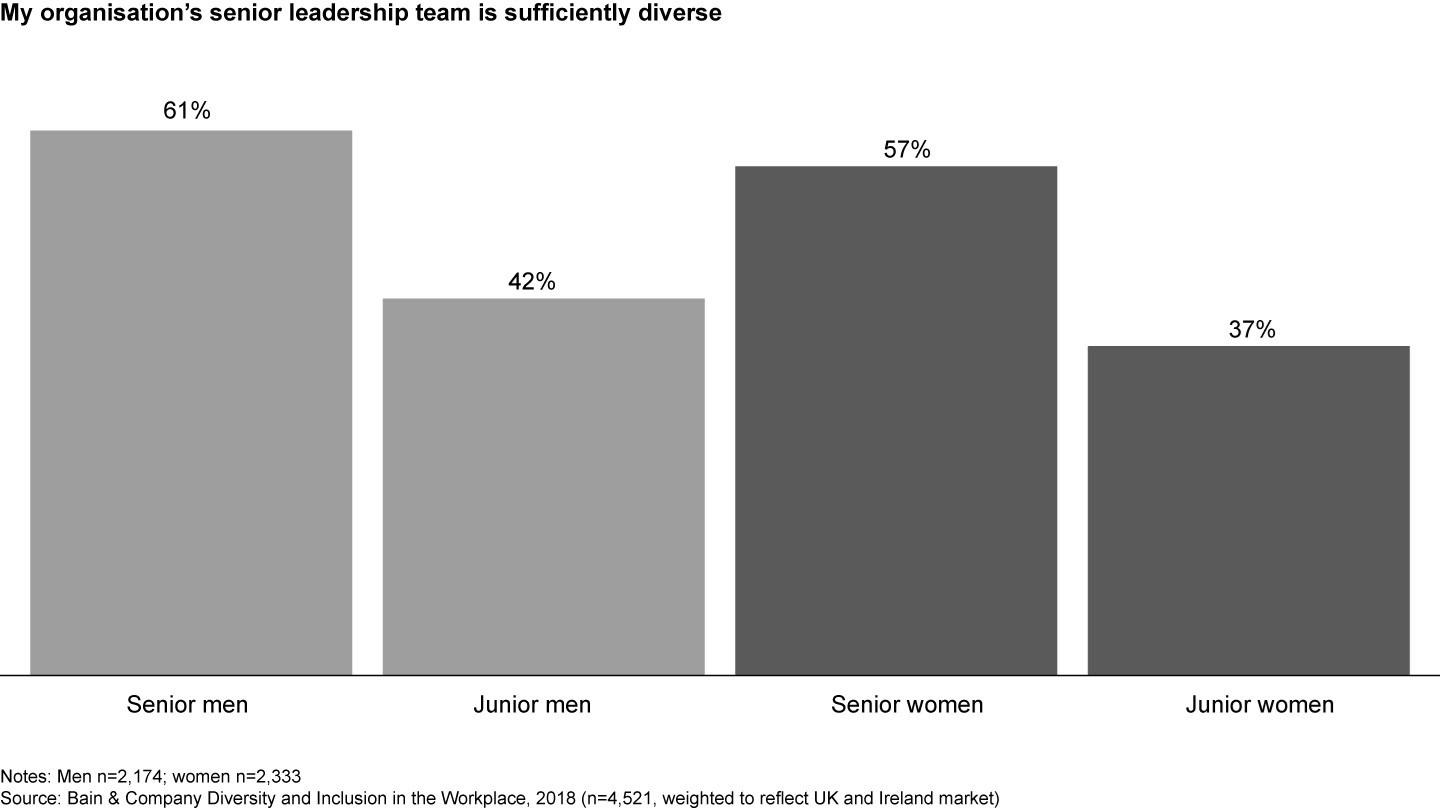
Without data, employees rely on anecdotes and perceptions to build a narrative about the organisation, which may perpetuate myths or unhelpful stereotypes. Companies must be thoughtful about how they engage in I&D conversations to shape the narrative.
We’ve observed three successful strategies for framing and communicating corporate I&D narratives to address the perception issue.
• Link diversity to the fundamental corporate purpose.
• Include everyone in the narrative.
• Fill the void with facts.
Link diversity to the fundamental corporate purpose
There’s a strong business case for organisations to pursue diverse leaders, employees and even customers. The benefits are increasingly well documented; ethnically mixed teams have more successful investments than those with shared ethnicity.
An organisation’s long-term vision, corporate values or strategic playbook can communicate the potential for inclusion and diversity to advance business priorities, such as growth. For instance, IBM, the global computer hardware and IT firm, considers global workforce diversity at the heart of its strategy to be one of the world’s leading integrated companies and to mirror the diversity of its global customer base.
Brenda Trenowden, CBE, global chair of the 30% Club and head of the Financial Institutions Group in Europe for ANZ, explains how placing emphasis on both diversity and inclusion can increase productivity and help build a supportive company culture.
Include everyone in the narrative
Good intentions can go awry. Inclusive messaging can backfire on organisations when they focus too narrowly on certain minority groups or fail to recognise all facets of diversity. Many organisations have found that I&D messaging resonates best with employees when the words “diversity” and “inclusion” are absent and when the message is framed from the perspective of all employees. For example, the UK division of Mars, the global manufacturer of confectionery, pet food and food products, has repositioned flexibility in its workplaces to be open for all, not just women.
A company’s actions in the real world can build pride within the team. Within Burberry, a British luxury fashion house, employees generally understood that the company welcomed members of the LGBTQ+ community. But once Burberry turned its position into an external campaign, employees reported feeling greater pride in the organisation.
Fill the void with facts
In the absence of information, speculation thrives. It’s in leaders’ best interest to be as proactive and transparent as possible when communicating I&D progress and actions. Celebrate successes and recognise shortcomings to build trust.
Young companies are redefining how this is done. Monzo, a mobile-only bank based in the UK, regularly publishes the demographic statistics of its workplace, which are gathered through an anonymous survey. The report sheds light on what the company is working on, and builds context and support around actions to improve inclusion and diversity.
Conclusion
Progress toward inclusion and diversity in the workplace has been slow. We must remember that the current status is reflective of decades-old practices and beliefs. Ambitious as we may be, we won’t overturn them overnight.
But there are many bright spots illuminating this journey. The advantages of inclusion and diversity are well documented and increasingly widely accepted. Attention to this issue is growing, with more enterprises and even governments stepping up and asserting their will to do better. Younger generations are demanding it.
The modern workplace can achieve inclusion and diversity. Examples such as BHP and others are bravely modelling the way and rewriting their legacies.
The five actions we described in this research offer a proven starting point for companies on the I&D journey. Through sustained and concerted action, companies can create environments in which both the enterprise and its employees thrive. With intention and focus, by taking action, we will gain traction.
-
Click to Expand: Research methodology
The 4,521 people who responded to the survey represent a range of positions and circumstances. Slightly more women than men responded: 52% compared with 48%, respectively. About half of the respondents are from private companies, 25% from publicly listed companies, and the balance from government, nonprofit or other organisations. About 70% of respondents are from organisations with more than 1,000 employees.
Within their organisations, about 10% of the respondents are junior employees; of this cohort, 30% identified as experienced workers, and 30% are junior to middle managers. Twenty percent are senior managers, and about 10% are leaders (that is, managing directors, executive-level team members or CEOs).
Fifty-five percent of the respondents are younger than 40 years old, while those between 40 and 60 years old make up 40% of the sample set, and the remainder is older than 60.
Sixty percent of respondents are married or in civil partnerships; 35% are single, and 5% are widowed, separated or divorced. About 55% of respondents have children.
Responses were weighted to ensure the overall sample was representative of the UK and Ireland workforces in regard to gender mix, industry and career level.
In addition, Bain & Company interviewed 50 human resources development experts and industry leaders. Our global experience working with client partners to diagnose and resolve I&D issues in their workplaces is reflected in the report as well.
Inclusion score out of 100% is based on agreement with nine equally weighted questions across three categories.
-
Role models: “My CEO role models inclusive behaviour”; “My direct supervisor role models inclusive behaviour.”
-
Day-to-day experiences: “I feel my ideas are heard and valued”; “I feel free to express my views and opinions in the workplace”; “I can be successful as my authentic self in my organisation”; “I feel comfortable and included at my company’s social or networking events.”
-
Organisational norms: “In my work environment, everyone is treated fairly regardless of personal background”; “My company is effective at retaining people with different backgrounds, characteristics and perspectives”; “Inclusion is a central part of my organisation’s values.”
-
-
Click to Expand: Employee Net Promoter Score
Our survey used the employee Net Promoter Score tool to gauge employees’ loyalty. We asked employees to rate on a scale of zero to 10 their likelihood to recommend working for their companies, managers or organisations. Depending on their scores, we grouped respondents into three categories.
-
Promoters (score of 9 or 10): People who feel their lives have been enriched by their relationships with their organisations or leaders. They behave like loyal employees, typically staying longer and talking up the organisation to their friends and colleagues.
-
Passives (score of 7 or 8): People who are fairly satisfied, but not loyal, employees. They rarely talk up their companies, and when they do, it’s likely to be qualified and unenthusiastic. If a better offer comes along, they are likely to defect.
-
Detractors (score of zero to 6): People who feel their lives have been diminished by their associations with their organisations or leaders. They are dissatisfied and even dismayed by how they are treated. They frequently speak negatively about their organisations and are likely to leave as soon as they find something better.
Our research has shown that employee engagement has proven and quantifiable impacts on company performance. Companies with higher employee Net Promoter Scores have distinct competitive advantages, including greater retention, higher levels of employee advocacy, overall better performance and faster growth.
-
-
Click to Expand: References
Agarwal, Dr. Pragya. “Here Is Why Organisations Need to Be Conscious of Unconscious Bias.” Forbes, 26 August 2018.
“Better Decisions through Diversity.” Kellogg Insight, 1 October 2010.
“Different Is Better: Why Diversity Matters in the Boardroom.” Russell Reynolds Associates, 2017.
Dinolfo, Sarah, and Julie S. Nugent. “Making Mentoring Work.” Catalyst, 2010.
Dobbin, Frank, and Alexadra Kalev. “Why Diversity Programs Fail.” Harvard Business Review, July–August 2016.
EMP04: Employment by occupation. Office for National Statistics, 11 September 2018.
EMP13: Employment by industry. Office for National Statistics, 13 November 2018.
Ethnicity facts and figures. GOV.UK, 2017.
Families and Households. Office for National Statistics, 8 November 2017.
Gompers, Paul, and Silpa Kovvali. “The Other Diversity Dividend.” Harvard Business Review, July–August 2018.
Hewlett, Sylvia Ann, Kerrie Peraino, Laura Sherbin, and Karen Sumberg. “The Sponsor Effect: Breaking Through the Last Glass Ceiling.” Harvard Business Review, 12 January 2011.
Hope, Katie. “How Long Should You Stay in One Job?” BBC News, 1 February 2017.
Ibarra, Herminia, Nancy M. Carter, and Christine Silva. “Why Men Still Get More Promotions Than Women.” Harvard Business Review, September 2010.
Johnson, Stefanie K., David R. Hekman, and Elsa T. Chan. “If There’s Only One Woman in Your Candidate Pool, There’s Statistically No Chance She’ll Be Hired.” Harvard Business Review, 26 April 2016.
Kalev, Alexandra, Frank Dobbin, and Erin Kelly. “Best Practices or Best Guesses? Assessing the Efficacy of Corporate Affirmative Action and Diversity Policies.” American Sociological Review, 71, no. 4 (September 2006): 589–617.
Kausel, Edgar E., Satoris S. Culbertson, and Hector P. Madrida. “Overconfidence in Personnel Selection: When and Why Unstructured Interview Information Can Hurt Hiring Decisions.” Organizational Behavior and Human Decision Processes 137 (November 2016): 27–44.
“Meet the Millennials.” KPMG, June 2017.
Parker, Sir John, and The Parker Review Committee. “A Report into the Ethnic Diversity of UK Boards.” EY, 12 October 2017.
“The PwC Diversity Journey: Creating Impact, Achieving Results.” PwC, September 2016.
“Race at Work 2018.” Business in the Community, 11 October 2018.
“Race Equality Awards 2017—EY: Ethnic Minority Leadership Progression.” Business in the Community, 2017.
Shkurko, Alexander V. “Is Social Categorization Based on Relational Ingroup/Outgroup Opposition? A Meta-Analysis.” Social Cognitive and Affective Neuroscience 8, No. 8 (December 2013): 870–877
“Social Mobility in Graduate Recruitment.” Rare Recruitment, 2016.
Werhane, William, and Mark Royal. “Engaging and Enabling Employees for Company Success.” Hay Group, October 2009.
This report was prepared by Clare Gordon and Sinead Fox, partners with Bain & Company’s London office, and with support from a team led by Danielle Burgs Escobar, a manager in the London office. You can contact the authors by email at clare.gordon@bain.com, sinead.fox@bain.com and danielle.burgsescobar@bain.com.
The authors thank Lili Chahbazi, Anna Thal Larsen, Mike Garstka and Barney Hamilton for their contributions.
We would also like to thank the following organisations for their participation and contribution: 30% Club Ireland, 30% Club UK, Hargreaves Lansdown, Mars, Moving Ahead/Women Ahead, Leathwaite, Paddy Power Betfair, Rare Recruitment and Timewise.
Net Promoter® , Net Promoter System® , Net Promoter Score® and NPS® are registered trademarks of Bain & Company, Inc., Fred Reichheld and Satmetrix Systems, Inc.